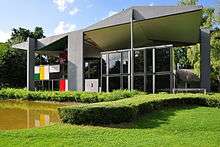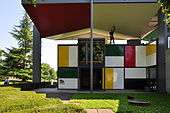Pavillon Le Corbusier
 | |
| Established | 1967 |
|---|---|
| Location | Zürichhorn, Switzerland |
| Coordinates | Coordinates: 47°21′22.86″N 8°33′4.03″E / 47.3563500°N 8.5511194°E |
| Type | art and biographical museum dedicated to the work of Le Corbusier |
| Founder | Heidi Weber |
| Curator | Heidi Weber, Bernard Weber and Prof. Dr. Felix Richner[2] |
The Pavillon Le Corbusier is a Swiss art museum in Zürich-Seefeld at Zürichhorn dedicated to the work of the Swiss architect Le Corbusier. In 1960 Heidi Weber had the vision to establish a museum designed by Le Corbusier – this building should exhibit his works of art in an ideal environment created by the architect himself in the then Centre Le Corbusier or Heidi Weber Museum. In April 2014 the building and museum went over to the city of Zürich, and was renamed in May 2016.[1]



Location
The building is located on the Zürichsee lake shore nearby Zürichhorn in the Seefeld quarter. It can be reached by foot (20 minutes from Bellevueplatz–Sechseläutenplatz) or by public transportation: Trams 2 and 4 and bus line 33 to stops Höschgasse or Fröhlichstrasse, or bus lines 912 and 916 from Bellevue to Chinagarten, or by the Limmat boats operated by the Zürichsee-Schifffahrtsgesellschaft (ZSG) towards Zürichhorn.
Centre Le Corbusier building
It is the last building designed by Le Corbusier marking a radical change of his achievement of using concrete and stone, framed in steel and glass, in the 1960s created as a signpost for the future. Le Corbusier made intensive use of prefabricated steel elements combined with multi-coloured enamelled plates fitted to the central core, and above the complex he designed a 'free-floating' roof to keep the house protected from the rain and the sun.
The most prominent architectural element, the roof, consists of two square parts, each side having a surface of 12 x 12 metres (39 ft). The total ground surface measures 12 x 26.3 metres (86 ft), consisting of welded metal sheets and having a weight of 40 tons. The roof was prefabricated and thereafter, in the biggest possible units, transported to the building site, where it was assembled on the ground. The two finally welded parts of the roof were then lifted to their final height (9 metres (30 ft)) by a crane and fixed on the pillars. With the frame thus completed, the construction process benefited from the independent roof protection which was at that time already in its proper place. It consists of cubes 2.26 x 2.26 metres (7.4 ft) which were assembled on the site. Walls, windows, ceilings and floors were then screwed onto the steel frame. The walls consist of enamelled panels measuring 1.13 metres (3.7 ft) x 2.26 metres (7.4 ft). The placing of these enamel panels was planned according to a particular rhythmic system. Finally, the entire building complex was placed on a concrete ground floor. The building has two floors – five single-storied and one double-storied rooms. When constructing the building complex, more than 20,000 bolts were used.
Museum
The Centre Le Corbusier can be considered a Gesamtkunstwerk, i.e. a total work of art, and reflects the harmonic unity of Le Corbusier's architecture, sculptures, paintings, furniture designs and his writings,[3] which is unique and possibly the only one such existing structure in the world. In 1968/69 Jürg Gasser's comprehensive photographic survey related to Chandigarh was exhibited; the Zürich photographer had visited the new capital of India's constituent state of Punjab on behalf of Heidi Weber.[4] While Heidi Weber removed Le Corbusier's sculptures, designs and mementos in mid-May 2016 for personal reasons, the city of Zürich as the new owner replaced these items from others sources respectively collections.[1]
History
In 1960 Le Corbusier was mandated by Heidi Weber, a Swiss art collector and patron, to conceive a public exhibition building. One year later, the first drawings for a building to be constructed in concrete were presented, in 1962 the concept was changed to a steel building. Two years later the construction was started. In 1965 Le Corbusier died, and on 15 July 1967, the Centre Le Corbusier was officially inaugurated.[2] On 13 May 1964 the city government presented the plot of land for the museum in construction law for 50 years free of charge. Therefore, on 13 May 2014 the building became the property of the city of Zürich represented by the newly created public Heidi Weber Foundation – Centre Le Corbusier. The board of trustees is represented by the city as well as by Mrs Heidi Weber: I welcome this solution. It helps me to be able to enter the house in new hands.[5][6] By April 2016 the Heidi Weber Foundation – Centre Le Corbusier preserved the last building designed by Le Corbusier, organized exhibitions, and collected and documents related to the architect's work.[2] In an interview end of May 2016, Heidi Weber stated that she's disappointed that the city of Zürich renamed the museum and building in Pavillon Le Corbusier, while ignoring the well-established name Heidi Weber Museum. Otherwise, municipal officials stated that the museum's name Centre Le Corbusier – Heidi Weber Museum was damned by Mrs Weber.[1] In mid-May 2016 Heidi Weber vacated the museum and removed images, sketches, sculptures, tapestry, furniture, the original models of the building, and an archive of Corbusier's letters and notes, after negotiations with the city of Zürich failed from her perspective. An agreement with Heidi Weber had failed at their price expectations, the mayor's office annotated. The museum is now admininistered by the cultural department of the city of Zürich, after the establishment of a foundation no longer was to realize, according to the city's officials, due to changes in the law. While a plaque at the museum's entrance shall point Weber's merits and hold the gratitude of the city of Zürich, Weber negotiates with the cities of Shanghai and Santiago de Chile on the opening of a Corbusier-house, her son complemented in the interview end of May 2016.[7]
Cultural heritage of national importance
The museum is listed in the Swiss inventory of cultural property of national and regional significance as a Class A object of national importance.[8]
Literature
- Heidi Weber – 50 Years Ambassador for Le Corbusier 1958–2008. Birckhäuser Publisher, 2009, ISBN 978-3-7643-8963-5.
References
- 1 2 3 4 Pascal Ritter (2016-05-29). "Streit um Corbusier-Haus: Respektlose Namenstilgung empört Museumsgründerin" (in German). Limmattaler Zeitung. Retrieved 2016-05-30.
- 1 2 3 "Curatorships, aims and purposes". heidiweberfoundation.com. Retrieved 2015-09-03.
- ↑ "Centre Le Corbusier / Museum Heidi Weber" (in German). stadt-zuerich.ch. Retrieved 2015-09-03.
- ↑ "Ausstellung 2015: Chandigarh sehen. Schweizer Reportagen" (in German). stadt-zuerich.ch. Retrieved 2015-09-03.
- ↑ "Jetzt gehört das Corbusier-Haus der Stadt". Tages-Anzeiger. 2014-05-12. Retrieved 2014-05-12.
- ↑ "Centre Le Corbusier: «Kulturelles Juwel» geht in den Besitz der Stadt Zürich" (in German). Limmattaler Zeitung. 2014-05-13. Retrieved 2015-09-03.
- ↑ Pascal Ritter (2016-05-28). "Streit um Corbusier-Haus" (in German). Schweiz am Sonntag. Retrieved 2016-05-31.
- ↑ "A-Objekte KGS-Inventar" (PDF). Schweizerische Eidgenossenschaft, Amt für Bevölkerungsschutz. 2015-01-01. Retrieved 2015-09-13.
External links
| Wikimedia Commons has media related to Centre Le Corbusier. |
- Pavillon Le Corbusier on the website of the city of Zürich (German)
- Website Heidi Weber Foundation – Centre Le Corbusier
- Website of the Heidi Weber Foundation
- Website The Heidi Weber House of Le Corbusier


